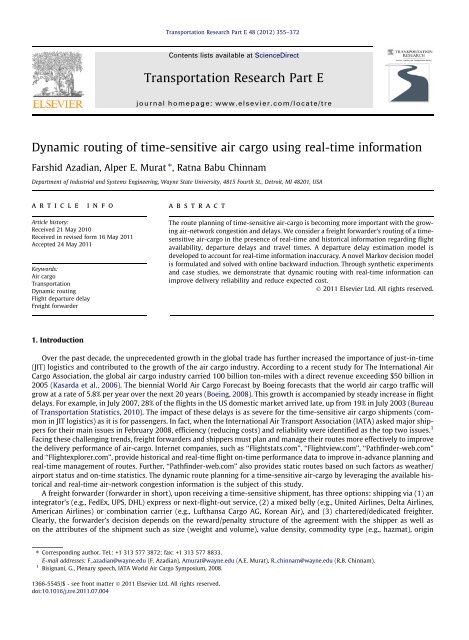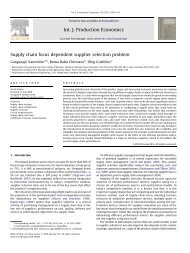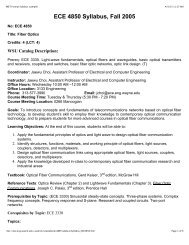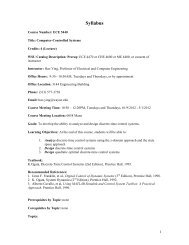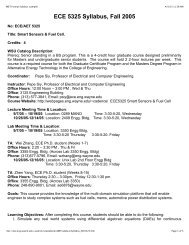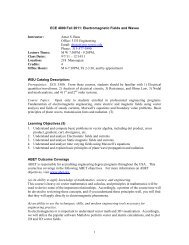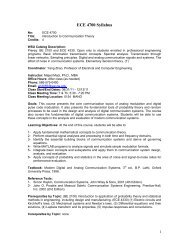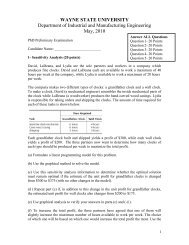Dynamic routing of time-sensitive air cargo using real-time information
Dynamic routing of time-sensitive air cargo using real-time information
Dynamic routing of time-sensitive air cargo using real-time information
- No tags were found...
You also want an ePaper? Increase the reach of your titles
YUMPU automatically turns print PDFs into web optimized ePapers that Google loves.
F. Azadian et al. / Transportation Research Part E 48 (2012) 355–372 357The rest <strong>of</strong> the paper is organized as follows. Survey <strong>of</strong> relevant literature is given in Section 2. Modeling the dynamic<strong>routing</strong> <strong>of</strong> <strong>air</strong> <strong>cargo</strong> and delay estimation is presented in Section 3. Section 4 presents the results <strong>of</strong> an experimental studyconducted to investigate the benefits <strong>of</strong> dynamic <strong>routing</strong> and accurate <strong>real</strong>-<strong>time</strong> flight status <strong>information</strong>. Two case studyapplications <strong>of</strong> the proposed approach are discussed in Section 5. Finally, Section 6 <strong>of</strong>fers concluding remarks and proposesavenues for future research.2. Literature reviewThe problem investigated in this study relates to multiple research streams. The proposed dynamic <strong>routing</strong> formulationand solution approach is closest to the stochastic <strong>time</strong>-dependent shortest path problems (STD-SP) and hence we restrict ourreview to those studies with stochastic and <strong>time</strong>-dependent arc travel costs. In terms <strong>of</strong> application, this study also relates tothe literature on the estimation <strong>of</strong> flight departure/arrival delays and cancellations/diversions which is briefly reviewed inthe end.The shortest-path problems are referred as STD-SP when arc costs follow a known probability distribution which is also<strong>time</strong>-dependent. Hall (1986) studied the STD-SP problems and showed that the optimal solution has to be an ‘adaptive decisionpolicy’ (ADP) rather than a static route. In an ADP, the node to visit next depends on both the node and the <strong>time</strong> <strong>of</strong> arrivalat that node, and therefore the classical SP algorithms cannot be used. Hall (1986) employed the dynamic programming(DP) approach to derive the optimal policy. Bertsekas and Tsitsiklis (1991) proved the existence <strong>of</strong> optimal policies for STD-SP. Later, Fu and Rilett (1998) modified the method <strong>of</strong> Hall (1986) for problems where arc costs are continuous random variables.They showed the computational intractability <strong>of</strong> the problem based on the mean-variance relationship between thetravel <strong>time</strong> <strong>of</strong> a given path and the dynamic and stochastic travel <strong>time</strong>s <strong>of</strong> the individual arcs. They also proposed a heuristicin recognition <strong>of</strong> this intractability. Bander and White (2002) modeled a heuristic search algorithm AO ⁄ for the problem anddemonstrated significant computational advantages over DP, when there exists known strong lower bounds on the total expectedtravel cost between any node and the destination node. Fu (2001) estimated immediate arc travel <strong>time</strong>s and proposeda label-correcting algorithm as a treatment to the recursive relations in DP. Waller and Ziliaskopoulos (2002) suggested polynomialalgorithms to find optimal policies for stochastic shortest path problems with one-step arc and limited temporaldependencies. Gao and Chabini (2006) designed an ADP algorithm and proposed efficient approximations to <strong>time</strong> and arcdependent stochastic networks. An alternative <strong>routing</strong> solution to the ADP is a single path satisfying an optimality criterion.For identifying paths with the least expected travel (LET) <strong>time</strong>, Miller-Hooks and Mahmassani (1998) proposed a modifiedlabel-correcting algorithm. Miller-Hooks and Mahmassani (2000) extended this algorithm by proposing algorithms that findthe expected lower bound <strong>of</strong> LET paths and exact solutions by <strong>using</strong> hyperpaths.All <strong>of</strong> the above studies on STD-SP assume deterministic <strong>time</strong> dependence <strong>of</strong> arc costs, with the exception <strong>of</strong> Waller and Ziliaskopoulos(2002) and Gao and Chabini (2006). However, the change in the cost <strong>of</strong> traversing an arc over-<strong>time</strong> can be stochasticas in the flight departure delays. Psaraftis and Tsitsiklis (1993) is the first study to consider stochastic temporal dependence <strong>of</strong>arc costs and to suggest <strong>using</strong> <strong>real</strong>-<strong>time</strong> <strong>information</strong> en route. They considered an acyclic network where the cost <strong>of</strong> outgoingarcs <strong>of</strong> a node is a function <strong>of</strong> the environment state <strong>of</strong> that node and the state changes according to a Markovian process. Theyassumed that the arc’s state is learned only when the vehicle arrives at the source node and that the state <strong>of</strong> nodes are independent.They proposed a DP procedure to solve the problem. Azaron and Kianfar (2003) extended Psaraftis and Tsitsiklis (1993) byevolving the states <strong>of</strong> current node as well as its forward nodes with independent continuous-<strong>time</strong> semi-Markov processes forship <strong>routing</strong> problem in a stochastic but <strong>time</strong> invariant network. Kim et al. (2005a) studied a similar problem as in Psaraftis andTsitsiklis (1993) except that the <strong>information</strong> <strong>of</strong> all arcs are available <strong>real</strong>-<strong>time</strong>. They proposed a dynamic programming formulationwhere the state space includes states <strong>of</strong> all arcs, <strong>time</strong>, and the current node. They stated that the state space <strong>of</strong> the proposedformulation becomes quite large, making the problem intractable. To address the intractable state-space issue, Kim et al.(2005b) proposed state space reduction methods. Thomas and White (2007) study a similar problem as in Kim et al. (2005a) butalso consider the amount <strong>of</strong> <strong>time</strong> that an observed arc has spent in a particular state. All these studies consider <strong>routing</strong> onunscheduled transport networks where there is no schedule induced or switching delays at the nodes as in scheduled networksor multimodal transportation, respectively. There are few studies on the <strong>routing</strong> problem on multimodal networks with <strong>time</strong>dependentarc weights (e.g., cost or travel <strong>time</strong>). Ziliaskopoulos and Wardell (2000) proposed a <strong>time</strong>-dependent intermodaloptimum path algorithm for deterministic multimodal transportation networks while accounting for delays at mode andarc switching points. Opasanon and Miller-Hooks (2001) proposed the stochastic variation <strong>of</strong> the approach by Ziliaskopoulosand Wardell (2000) where the mode transfer delays and arc travel <strong>time</strong>s are stochastic and <strong>time</strong> varying. However, this studyassumes independence over <strong>time</strong> for all probability distributions. Our proposed dynamic <strong>routing</strong> model differs from earliermodels in the STD-SP literature by accounting for the scheduled departures, the effect <strong>of</strong> stochastic travel <strong>time</strong>s and departuredelays. In addition, it admits the <strong>real</strong>-<strong>time</strong> announced <strong>information</strong> on the status <strong>of</strong> flights and makes <strong>routing</strong> decisions and updatesthe delay distributions based on this online <strong>information</strong>.The estimation <strong>of</strong> flight departure/arrival delays and cancellations/diversions has been the subject <strong>of</strong> several studies(Mueller and Chatterji, 2002; Chatterji and Sridhar, 2005; Tu et al., 2008). These studies can be categorized into analytical(e.g. queuing), statistical (e.g. regression models) and simulation approaches that vary by computational efficiency and level<strong>of</strong> detail. For example, the delay and cancellation component in the Federal Aviation Administration (FAA) NAS Strategy Simulatortakes a macroscopic approach and obtains approximations <strong>of</strong> delay based on the aggregate values <strong>of</strong> input parameters,namely traffic demand and <strong>air</strong>port capacity. The majority <strong>of</strong> delay estimation approaches proposed in the literature predict
360 F. Azadian et al. / Transportation Research Part E 48 (2012) 355–372imperfect. To simplify the notation, we will suppress the <strong>time</strong> from the announced delay and use ^d i instead. Given the announceddelay ^d i , the distribution Pðd i j^d i Þ represents the degree <strong>of</strong> accuracy in the departure delay announcement, e.g.Pðd i ¼ d i j^d i Þ corresponds to the case <strong>of</strong> perfect <strong>information</strong>. However, once the <strong>real</strong>-<strong>time</strong> announcement (d i ) on the departuredelay (d i ) is revealed, we assume that the <strong>information</strong> is tail conditionally accurate such that the flight will not depart earlierthan the announced departure delay, i.e. P(d i ) = 0 for d i 6 ^d i . Note that if there is no announcement, then either the flight departson <strong>time</strong> or will be delayed without an announcement. In the latter case, the announced delay is considered as a zerodelay announcement, e.g. ^d i ¼ 0. We assume announced delays can be updated but are non-decreasing with <strong>time</strong>, i.e.^d i ðt 1 Þ 6 ^d i ðt 2 Þ for t 1 6 t 2 .Given the historical data on announced and actualized delays, one can estimate the conditional probability <strong>of</strong> the actualizeddelay given the announced delay. The estimation <strong>of</strong> Pðd i ¼ d i j^d i Þ requires the availability <strong>of</strong> sufficient historical data onthe actualized departure delays and the associated announced delays. For any given flight, these historical data sets are usuallysparse considering the effect <strong>of</strong> other determining factors such as seasonality (e.g., <strong>time</strong> <strong>of</strong> the day, day <strong>of</strong> the week,month) and non-recurring events (e.g., weather conditions, special days). Accordingly, we instead approximate this distributionby considering the intervals for the announced delay, ^d i 2 v r i ; v rþ1i for r =1,...,m, where vriand v rþ1idefine the upperand lower bound on the departure delay for interval r, respectively. Note that v r 1i6 v r 2ifor r 1 6 r 2 and v 1 i¼ 0 and v mþ1i¼ n.The delay intervals v r i ; vrþ1 i can be determined through a bi-variate clustering method (e.g. Gaussian Mixture Model clustering), which can then be used to estimate the joint distribution <strong>of</strong> announced and actualized departure delay, e.g.P v r0i6 d i 6 v r0 þ1i; v r i6 ^di 6 v rþ1i. Hence, prior to receiving any departure delay <strong>information</strong> (e.g. delay announcement)and before the scheduled departure <strong>time</strong>, the delay distribution <strong>of</strong> a delayed flight i satisfies P r P r¼ 1 whereP r ¼ P v r i6 d i 6 v rþ1i . Given that the announced delay <strong>information</strong> is tail conditionally accurate, we have P(di ) = 0 ford i 6 v r iand v r i6 d i 6 ^d i where ^d i 2 v r i ; v rþ1i . Therefore, number <strong>of</strong> intervals (m) determines the announcement fidelity,e.g. the larger the m, the more accurate the announcements are.Based on announced delay intervals, for a given flight i, wecalculate the probability density function <strong>of</strong> departure delayfor a given 1 6 r 6 m as,given departure delay announcement ^d i , where ^d i 2 v r i ; v rþ1i P d i v r i6 ^d i 6 v rþ1i¼ Xm P d iv r0i6 d i 6 v r0 þ1i P vr 0i6 d i 6 v r0 þ1iv r i6 ^d i 6 v rþ1ir 0 >r þ P d i ^di 6 d i 6 v rþ1iP ^d i 6 d i 6 v rþ1iv r i6 ^d i 6 v rþ1i: ð1ÞNote that P v r0i6 d i 6 v r0 þ1iv r i6 ^d i 6 v rþ1ifor r 0 < r and the last term in (1) corresponds to the case r 0 = r. From the Bayes’rule, we have,P v r0i6 d i 6 v r0 þ1v r i6 ^dP v r0 i 6 v rþ1i6 d i 6 v r0 þ1i;v r i6 ^di 6 v rþ1i¼ for r 0 > r; ð2ÞP ^d i 6 d i 6 v rþ1We calculate P d iv r0P d iv r0iii6 d i 6 v r0 þ1iiv r i6 ^d i 6 v rþ16 d i 6 v r0 þ1i¼P d i ;v r0iii¼P v r i6 ^d i 6 v rþ1iP ^d i 6 d i 6 v rþ1i; v r i6 ^di 6 v rþ1i : ð3ÞP v r i6 ^d i 6 v rþ1iin (1) for r 0 > r and d i 2 v r0i ; v r0 þ1i as,P v r0i6 d i 6 v r0 þ1i ¼6 d i 6 v r0 þ1iW v r0 þ1iwðd i ÞW v r0iFor d i v r0i ; v r0 þ1i , we have P di v r0i6 d i 6 v r0 þ1i ¼ 0.Similar to the derivation <strong>of</strong> (4), the density in the second term <strong>of</strong> (1) for d i 2P d i ^di 6 d i 6 v rþ1 wðd i Þi¼ W v rþ1iWð^d i Þ ;and is 0 if d i v r0i ; þ1vr0 i .Hence, the conditional delay distribution is as follows:0 P d i v r i6 ^dP i 6 v ^d i 6 d i 6 v rþ1rþ1ii¼ wðd i Þ@W v rþ1iWð^d i Þv r i6 ^d i 6 v rþ1i: ð4Þþ Xmr 0 >rP v r0i^d i ; v rþ1i6 d i 6 v r0 þ1iW v r0 þ1iis expressed as,v r i6 ^d i 6 v rþ1W v r0iið5Þ1A: ð6ÞFor m = 1 (e.g. v 1 i¼ 0 and v 2 i¼ n) and ^d i ¼ 0, the expression in (6) is w(d i ). For notational simplicity, we define conditionaldelay distribution <strong>of</strong> flight i at <strong>time</strong> t with announced delay v r i6 ^d i 6 v rþ1q i ðd i ; ^di Þ¼P d i ¼ th i v r i6 ^d i 6 v rþ1iias:; ð7ÞNote that we suppress t for q i ðd i ; ^d i Þ in (7) and assume that it will be clear from the context. We further define the cumulativeprobability that the delayed flight i departs at or after t as:
F. Azadian et al. / Transportation Research Part E 48 (2012) 355–372 361Q i ðt; ^d i Þ¼ Xh iþnq i ðd i ¼ t 0 h i ; ^d i Þ; ð8Þt 0 ¼tIn the next section, we describe our dynamic programming model for <strong>air</strong> <strong>cargo</strong> <strong>routing</strong>.3.2. <strong>Dynamic</strong> programming model for <strong>air</strong> <strong>cargo</strong> <strong>routing</strong>The objective <strong>of</strong> the dynamic <strong>air</strong> <strong>cargo</strong> <strong>routing</strong> model is to minimize the expected cost criteria for a trip originating atorigin n o and concluding at destination n d . The cost criteria can be a function <strong>of</strong> the service level (e.g. delivery <strong>time</strong>), a penaltyfunction measuring earliness/tardiness <strong>of</strong> arrival <strong>time</strong> to the final destination, itinerary cost or a weighted combination <strong>of</strong>these criteria. We assume that the forwarder has already booked an itinerary (called static path) and thus secured the <strong>cargo</strong>space availability on this path. As long as the forwarder does not deviate from the static path, there are no additional flightbooking and handling costs; otherwise there is a one-<strong>time</strong> penalty for breaching the booking contract.Consider a flight path p between (n o ,n d ) where p =(i 1 ,i 2 ,...,i k ,...,i K ), k =1,2,...,K is defined as sequence <strong>of</strong> flights suchthat i k 2 A lk where l k ðn 0 l k; n 00l kÞ and n 0 l kþ1 n 00l k. Note that n 0 l 1 n o and n 00l K n d . Let p S indicate the static path. Denote theset I(n,t) # A as the set <strong>of</strong> flights scheduled to depart from node n with departure <strong>time</strong>s h i 6 t for "i 2 I(n,t). Each node ona flight path is a decision stage (or epoch) at which a <strong>routing</strong> decision (i.e., which flight to select next) is to be made. Letn k be the <strong>air</strong>port location <strong>of</strong> k th decision stage, t k is the <strong>time</strong> at k th decision stage where t k 2 {1,...,T}, T > t K . Note that weare discretizing the planning horizon. Since the objective <strong>of</strong> our dynamic <strong>air</strong> <strong>cargo</strong> <strong>routing</strong> model can be expressed as anadditive function <strong>of</strong> the cost <strong>of</strong> individual stages on the flight path, the dynamic flight selection problem can be modeledas a dynamic programming model.The state <strong>of</strong> the system at kth decision stage is denoted by X k ¼ X n k ; t k ; D b k ; z k S. This state vector is composed <strong>of</strong> the state<strong>of</strong> the <strong>air</strong> <strong>cargo</strong> and flight network and is thus characterized by the current node (n k ), the current node arrival <strong>time</strong> (t k ), andthe announced departure delay state <strong>of</strong> all flights at <strong>time</strong> t k at stage k, i.e., Dkb ¼f^d i ; 8i 2 Ag, and static route indicator, i.e.,z k S ¼ 1 if the flights are selected from the static route until stage k and zk S¼ 0 otherwise. After the <strong>air</strong> <strong>cargo</strong> is loaded on toa flight, there is a chance that the flight becomes unavailable (e.g., cancelled) or forwent without a penalty due to excessivedelay. In either case, the forwarder is faced with the task <strong>of</strong> choosing another flight. It can be shown that an optimal policydecision is to account for not only the first flight choice but collectively all recourse flights. Therefore, we define the actionspace for the state X k as the set <strong>of</strong> all orderings <strong>of</strong> all the available flights scheduled to depart from <strong>air</strong>port n k denoted with I o (n k ,t k ). Note that this list accounts for all the restrictions experienced by the freight forwarders such as the restriction <strong>of</strong> the <strong>air</strong>craftfor certain ULD classes and unavailability <strong>of</strong> spot capacity on a certain flight at t k .At every decision stage, the <strong>air</strong> <strong>cargo</strong> freight forwarder evaluates the alternative flight orderings from the ‘‘current’’ nodebased on the expected cost-to-go. The expected cost-to-go at a given node with the selection <strong>of</strong> a flight ordering is the expectedtotal cost <strong>of</strong> the flight ordering selected and the cost-to-go from the next node. Let p ={p 1 ,p 2 ,...,p K } be the policy <strong>of</strong>the <strong>routing</strong> and is composed <strong>of</strong> policies for each <strong>of</strong> the K 1 decision stages. For a given state X k , the policy p k(X k )isadeterministic Markov policy that chooses an ordering <strong>of</strong> flights departing from node n k , i.e., p k (X k ) 2 I o (n k , t k ). Therefore, theexpected total cost for a given policy vector p ={p 1 ,p 2 ,...,p K } is as follows:( )Fðn o ; t 1 ; D b 1 ; 1jpÞ ¼E Dk g Kþ1 ðX Kþ1 Þþ XKg k ðX k ; p k ðX k Þ; D k Þ ; ð9Þk¼1where ðn o ; t 1 ; b D 1 ; 1Þ is the starting state <strong>of</strong> the system and the D k is the actualized departure delay vector at stage k. The singlestage cost g k (X k , p k (X k ),D k ) is cost <strong>of</strong> the flight ordering selected given the actualized departure delay D k . The g K+1 (X K+1 )is the penalty function based on the earliness/tardiness <strong>of</strong> arrival <strong>time</strong> to the final destination n d . Then, the minimum expectedtotal cost can be found by minimizing F o ðn o ; t 1 ; b D 1 ; 1Þ over the policy vector p ={p 1 ,p 2 ,...,p K } as follows:F ðn o ; t 1 ; D b 1 ; 1Þ ¼ min Fðn o ; t 1 ; D b 1 ; 1jpÞ:p¼fp 1 ;p 2 ;...;p K gð10ÞThe corresponding optimal policy is then,p ¼ min Fðn o ; t 1 ; D b 1 ; 1jpÞ:p¼fp 1 ;p 2 ;...;p K gð11ÞHence, the Bellman’s cost-to-go equation can be expressed as follows (Bertsekas, 2005):F ðX k Þ¼minp kE Dk fg k ðX k ; p k ðX k Þ; b D k ÞþF ðX kþ1 Þg 8k ¼ 1; ...; K: ð12ÞWe now derive the F ⁄ (X k )in(12). Consider the kth decision stage where the <strong>air</strong> <strong>cargo</strong> has arrived to node n k at t k . An outboundflight from n k can be in either available or unavailable state at t k . Let c i denote the steady-state probability that flight iis not cancelled or diverted and has also sufficient capacity. 6 Then the probability that the i th flight is available at t k and candepart with the <strong>air</strong>-<strong>cargo</strong>, P i ðt k ; ^d i Þ, is calculated as follows,6 Note that we also include in this probability the cases where the flight can be delayed longer than the threshold n.
362 F. Azadian et al. / Transportation Research Part E 48 (2012) 355–372P i ðt k ; ^d i Þ¼c iQ i ðt k ; ^d i Þ:ð13ÞTherefore, the chance <strong>of</strong> loading the <strong>cargo</strong> on a flight increases with the cumulative probability that the delayed flight i departsat or after t given the announcement ^d i . For notational simplicity, we also define P i ðt k ; ^d i Þ¼1 P i ðt k ; ^d i Þ. Note that Eq.(13) assumes that the cancellation/diversion and delay decision processes are complementary, e.g., on-<strong>time</strong> or delayed if notcancelled. When the on-<strong>time</strong> departures are not possible with reasonable delay (due to a late arrival, mechanical, weather,congestion, or staffing issue), the carrier or <strong>air</strong>port then opts to cancel (Jarrah et al., 1993; Rupp and Holmes, 2006).For a given state X k ,C i (X k ) is the cost <strong>of</strong> selecting flight i and depends on whether the route deviates from the static path.The C i (X k ) can be in one <strong>of</strong> the three cases (I, II, orIII),8>< 0 if i ¼ p S ðkÞ and z k S¼ 1; ðCase IÞ;C i ðX k Þ¼ L i if z k S¼ 0; ðCase IIÞ;ð14Þ>:H þ L i if i – p S ðkÞ and z k S¼ 1; ðCase IIIÞ;where p S (k) is the kth flight in the static route, L i is the <strong>air</strong> <strong>cargo</strong> and handling fare <strong>of</strong> flight i, and H is the penalty cost <strong>of</strong>forgoing the static itinerary, e.g. the <strong>air</strong> <strong>cargo</strong> booking price for the static itinerary. The case (I) corresponds to maintainingthe static path by choosing flight i from the static path. The case (II) corresponds to the scenario where the route has alreadydeviated from the static path and thus L i is incurred for <strong>using</strong> flight i. Case III corresponds to deviating from the static path instage. In cases (I) and (II), we assume that once the route deviates from the static path, all future flights are booked with fullbooking fee. In lieu, one can assume flights on static path can be used at a cost less than full fee b L i < L i , i.e., for case (II),C i (X k )=L i if i – p S (k) and z k S ¼ 0, and, C iðX k Þ¼ b L i if i ¼ p S ðkÞ and z k S¼ 0: We note that certain privileges such as the availability<strong>of</strong> discount fares and waivers for route changes are captured through H and L i .Subsequently, the cost-to-go <strong>of</strong> flight i at <strong>time</strong> t k with departure delay <strong>information</strong> D b k is calculated as,f in k ; t k ; D b k ; z k S¼ C i ðX k Þþ X Xd is iq i ðd i ; ^d i ÞPðs i jd i ÞF ðn kþ1 ; h i þ d i þ s i ; b D kþ1 ; z kþ1SÞ; ð15Þwhere C i stage k cost <strong>of</strong> choosing flight i, d i is the stochastic departure delay satisfying ^d i 6 d i 6 n, the h i + d i + s i is the stochasticarrival <strong>time</strong> to n kþ1 ; q i ðd i ; ^d i Þ is the conditional departure delay probability in (10), probability P(s i jd i ) is the conditionalprobability <strong>of</strong> the travel <strong>time</strong> given the departure delay, and z kþ1S¼ 1ifz k S ¼ 1 and i = p S(k) and z ðkþ1ÞS¼ 0 otherwise.Let p k 2 I o (n k , t k ) denote a flight ordering <strong>of</strong> all the available flights at t k outgoing from node n k . This ordering is determinedbased on the cost-to-go <strong>of</strong> individual flights, i.e. (j)
F. Azadian et al. / Transportation Research Part E 48 (2012) 355–372 3634. Experimental studyExperimental study investigates the effect <strong>of</strong> such problem parameters as accuracy <strong>of</strong> announced delay <strong>information</strong>, distributionparameters <strong>of</strong> the departure delay, effect <strong>of</strong> travel <strong>time</strong> variability, and number <strong>of</strong> <strong>air</strong>-connections on various performancecriteria (e.g., expected cost and delivery reliability).The experimental study is based on five problem configurations ðN 0 ; N 1 ; N 2 ; N 3 ; N 4 Þ as illustrated in Fig. 2 togetherwith the problem parameters. The parameters for every flight are the probability <strong>of</strong> on-<strong>time</strong> departure (a), the expecteddeparture delay (l) if the flight is delayed, the scheduled departure <strong>time</strong> (h), and the mean (s) and standard deviation (r)<strong>of</strong> the Gaussian travel <strong>time</strong> distribution. In all configurations, the origin <strong>air</strong>port is A (origin), the destination <strong>air</strong>port is D (destination),and there are two alternative intermediate <strong>air</strong>ports (B and C) with inbound flights from the origin <strong>air</strong>port. Furthermore,the expected total trip <strong>time</strong> <strong>of</strong> going through B or C is same for all three networks.The N 0 configuration represents the baseline configuration from which the other network configurations are constructed.In the baseline, the flights’ travel <strong>time</strong>s are deterministic; i.e. r AB = r CD = r AC = r BD = 0. The mean travel <strong>time</strong>s forflights between the same <strong>air</strong>port p<strong>air</strong> are same as shown in Fig. 2, e.g. E(s) = 200 for flights 5, 6, and 9 between B and Din N 0 . The N 1 and N 2 configurations are identical to the baseline except for the standard deviation <strong>of</strong> the flights’ travel<strong>time</strong>s. In the N 1 configuration, coefficient <strong>of</strong> variation (CV) for flights’ travel <strong>time</strong>s are set at 5%, i.e., r AB = r CD = 5 andr AC = r BD = 10. In the N 2 configuration, CV is set at 20%, i.e., r AB = r CD = 20 and r AC = r BD = 40. The N 3 network configurationis identical to the baseline except that direct flights from B to D are replaced with one-stop flights connecting at node E. TheN 4 network differs from the baseline at <strong>air</strong>port C, where we consider six scenarios, e.g. [S 1 ,S 2 ,S 3 ,S 4 ,S 5 ,S 6 ], for the departuredelay distribution <strong>of</strong> the outgoing flights (7,8,10). Note that the expected delay <strong>of</strong> flights (7,8,10) are identical in all six scenarios.We assume that, at t 0 = 95, the <strong>cargo</strong> is processed and ready for loading onto the first available flight. Further, the duedate is set at T = 100, e.g., the <strong>cargo</strong> requires expedited shipment. In order to better understand the effect <strong>of</strong> parameters andwithout loss <strong>of</strong> any generality, we consider total trip <strong>time</strong> as the performance measure and assume there are no cancellationsand capacity constraints.Fig. 2. Network structure and parameters for five problem configurations (N 0 to N 4).
(a)Improvement (%)100806040200F. Azadian et al. / Transportation Research Part E 48 (2012) 355–372 365Improvement <strong>of</strong> <strong>Dynamic</strong> Policyover Static Policy1 2 3 4 5Announced Delay Accuracy(b)Improvement (%)100806040200Improvement <strong>of</strong> <strong>Dynamic</strong> Policyover Static PolicyS1 S5 S1 S5 S1 S5m=1 m=2 m=5Fig. 4. Improvement (q) <strong>of</strong> dynamic policy over static policy for N 0; N 1; N 2; N 3 (a) and N 4 (b).policy a truncation on the delay distribution experienced by flight 7. In summary, the choice <strong>of</strong> flight paths depends on thepolicy used. The static policy trade<strong>of</strong>fs the tardiness <strong>of</strong> a fixed path with the risk <strong>of</strong> missing a connecting flight. On the otherhand, the dynamic policy exploits both the <strong>real</strong>-<strong>time</strong> departure delay <strong>information</strong> (whenever available) and the multiplicity<strong>of</strong> flights departing from connecting <strong>air</strong>ports.Fig. 4a indicates that the rate <strong>of</strong> improvement with increased accuracy is diminishing for N 0 to N 3 . Further, the dynamicpolicy can achieve the majority <strong>of</strong> performance improvement even with some level <strong>of</strong> <strong>real</strong>-<strong>time</strong> delay <strong>information</strong>. An increasein travel <strong>time</strong> variability decreases the dynamic policy’s performance improvement over the static alternative, e.g.N 0 versus N 1 and N 2 . The effect <strong>of</strong> delay distribution is illustrated in Fig. 4b. For S 5 , the on-<strong>time</strong> departure probabilityis very high and there is some level <strong>of</strong> truncation <strong>of</strong> the experienced delay at the <strong>air</strong>port C, and thus dynamic policy is betterperforming than S 1 . With increasing m, the dynamic policy’s performance is increasing and is robust with respect to the delaydistribution due to the truncation effect on the experienced delay in <strong>air</strong>port C.Another important performance measure for the shippers and freight forwarders is the delivery reliability, i.e., the percentage<strong>of</strong> shipments arriving on <strong>time</strong>. Fig. 5 shows the conditional expected tardiness for N 0 ; N 3 , and N 4 at different levels<strong>of</strong> announced delay accuracy and delivery due dates. Fig. 5a and b illustrate that increasing <strong>information</strong> accuracy improvestardiness performance. Case for N 3 is similar to N 0 , but the difference in static and dynamic policy tardiness is moreremarkable. In the case <strong>of</strong> N 4 , the conditional expected tardiness <strong>of</strong> two policies with no <strong>real</strong>-<strong>time</strong> <strong>information</strong> is similarand in<strong>sensitive</strong> to the delay distribution (Fig. 5c). Further, with the increased level <strong>of</strong> announced delay accuracy, the effect<strong>of</strong> the delay distribution on the conditional expected tardiness diminishes.5. Case studiesIn this section, we first briefly describe the estimation <strong>of</strong> delay and travel <strong>time</strong> distribution model parameters <strong>using</strong> <strong>real</strong>worlddata sources. Next, we describe two case study applications and discuss their analysis results.5.1. Estimation <strong>of</strong> flight departure delay and travel <strong>time</strong>The flight i is delayed with probability (1 a i ) and the corresponding departure delay (d i ) has non-negative and continuousprobability density w(d i ) and cumulative density W(d i ). We estimate these probabilities <strong>using</strong> the publicly available historicaldatabases. The departure delay depends on a number <strong>of</strong> factors such as seasonality (e.g. <strong>time</strong> <strong>of</strong> the day, etc.), originand destination <strong>air</strong>ports, carrier, weather, special days and other non-recurring events. The databases <strong>of</strong> the BTS and the OPS-NET provide detailed multi-year historical on-<strong>time</strong> departure and departure delay <strong>information</strong> on all the US domestic flightsand major US <strong>air</strong>ports. The data in both the BTS and the OPSNET are either aggregated at the facility level or available only forthe passenger flights. Since our <strong>routing</strong> model is applicable to both dedicated carriers as well as passenger carriers, we assumethat departure delay for <strong>cargo</strong> carrying flight can be approximated with the delay data for mixed passenger/carg<strong>of</strong>lights. This assumption can be justified by considering the fact that in both cases the flights are affected by similar factors(Mueller and Chatterji, 2002; Chatterji and Sridhar, 2005). These delay data are extracted for each combination <strong>of</strong> the determiningfactors to estimate the most accurate non-parametric delay distribution for each flight. However, due to small samplesizes, we aggregated the data by selecting the origin <strong>air</strong>port, destination <strong>air</strong>port, month <strong>of</strong> the year and <strong>time</strong> <strong>of</strong> the day as thefactors to be included. These factors are identified as most significant by conducting multiple analysis <strong>of</strong> variance tests.In case study applications, we considered the month <strong>of</strong> June in 2009. First, we estimated the percentage <strong>of</strong> on-<strong>time</strong> departures(a i ) and the cancellation and diversion percentages (c i ). We considered those flights with delays in excess <strong>of</strong> n = 90 minas cancelled. After filtering out the on-<strong>time</strong> departures, cancellations and diversions from the data collected, we estimatedthe departure delay distributions. While any <strong>of</strong> the non-parametric estimation techniques are suitable, we considered variouscommon distributions for presentation purposes. The goodness <strong>of</strong> fit tests <strong>of</strong> common distributions indicated that the
368 F. Azadian et al. / Transportation Research Part E 48 (2012) 355–372Fig. 7. Marginal distribution <strong>of</strong> departure delay and travel <strong>time</strong> for LGA-ORD flights for cluster 2.Table 1LGA to SEA <strong>time</strong>-<strong>sensitive</strong> <strong>air</strong> <strong>cargo</strong> <strong>routing</strong> case study.Flight label Carrier Flight num. From To Sch. dep. Departure delay Duration (min)Mean (min) On-<strong>time</strong> (%) Mean Std. dev.1 AA 303 LGA ORD 6:55 35 58 145 52 AA 305 LGA ORD 7:29 41 48 149 153 NW 541 LGA DTW 6:00 6 43 117 134 NW 533 LGA DTW 7:25 21 60 117 105 NW 1424 LGA MSP 6:00 28 51 182 126 NW 1646 LGA MSP 8:15 26 53 185 167 AA 1843 ORD SEA 9:30 19 56 263 128 AA 313 ORD SEA 12:15 25 64 256 129 NW 211 DTW SEA 9:33 44 53 296 1310 NW 215 DTW SEA 12:19 27 66 291 1011 NW 167 MSP SEA 12:45 18 61 224 11icy’s distribution. The dynamic policy exploits the availability <strong>of</strong> departure delay <strong>information</strong> and chooses earlier but riskierflights. In comparison, the static policy chooses a path <strong>of</strong> flights with a high probability <strong>of</strong> being available. Fig. 9a illustratesthat the expected value <strong>of</strong> the static and dynamic policy distributions are identical for the case m = 1. With increasedannouncement accuracy (m = 2), we note that the dynamic policy’s distribution shifts towards left as a result <strong>of</strong> choosingpath (3–9) more than before. This corresponds to about 70% performance improvement over the static policy (Fig. 9b). Withm = 5, the frequency <strong>of</strong> long trip durations is minimized and the performance improvement is about 86%. The ability tochange the flight decisions online provides the dynamic policy the ability to choose the earlier flights with recourse options.Therefore, the dynamic policy is not only superior in the expected sense but can also provide early delivery performancewhich cannot be attained by a static policy. Whereas the earliest delivery for the static policy is at 822 min, the dynamicpolicy can attain deliveries as early as at 792 min.This case study illustrates that dynamic policy can significantly enhance the <strong>routing</strong> performance, especially when the<strong>information</strong> accuracy is high. It also illustrates that dynamic policy may not lead to significantly better results in the case<strong>of</strong> limited route alternatives and low <strong>information</strong> accuracy.5.1.2. Case Study II: La Guardia Airport (LGA) to Dallas Fort Worth International Airport (DFW)This case study considers the <strong>routing</strong> <strong>of</strong> a <strong>time</strong>-<strong>sensitive</strong> <strong>air</strong>-<strong>cargo</strong> from LGA to DFW at 6:00 a.m. on Tuesday, June 16,2009. We consider three <strong>air</strong>-carriers: US Airways (US), Delta Airlines (DL) and NW. Table 2 presents problem parametersand distributions.Fig. 10a shows the flight path frequency for the two policies. With m = 1, the static and dynamic policies prefer pathsthrough Atlanta (flights 1 then 12) and Charlotte (flights 10 then 21), respectively. The expected travel <strong>time</strong> <strong>of</strong> path
F. Azadian et al. / Transportation Research Part E 48 (2012) 355–372 369Fig. 8. Travel <strong>time</strong> distributions for different announcement accuracy levels (LGA-SEA case study).(a)(b)Fig. 9. LGA to SEA case study, flight path frequency (a) and improvement (b).(1–12) is less than path (10–21). However, the flights 12 and 13 are missed in Atlanta with recourse to flights 13 and 14.With more accurate <strong>information</strong> on departure delay, e.g. m = 2 and m = 5, the dynamic policy reduces the missed flights13 and 14 by following path (10–21) when advantageous. Fig. 10b illustrates that the expected performance improvement<strong>of</strong> dynamic <strong>routing</strong> policy over static policy. Clearly, even for limited <strong>information</strong> accuracy, dynamic can <strong>real</strong>ize 20% perfor-
370 F. Azadian et al. / Transportation Research Part E 48 (2012) 355–372Table 2LGA to DFW <strong>time</strong>-<strong>sensitive</strong> <strong>air</strong> <strong>cargo</strong> <strong>routing</strong> case study.Flight label Carrier Flight num. From To Sch. dep. Departure delay Duration (min)Mean (min) On-<strong>time</strong> (%) Mean Std. dev.1 DL 19 LGA ATL 6:00 42 45 174 142 DL 533 LGA ATL 7:00 36 77 170 133 DL 423 LGA ATL 8:00 14 83 165 154 NW 541 LGA DTW 6:00 6 43 117 65 NW 533 LGA DTW 7:25 21 60 117 106 NW 172 LGA MEM 6:30 14 84 163 137 NW 509 LGA MEM 11:00 22 77 165 178 NW 1424 LGA MSP 6:00 28 51 182 129 NW 525 LGA MSP 8:15 26 53 185 1610 US 1455 LGA CLT 6:30 13 93 112 811 US 1021 LGA CLT 8:10 18 93 115 1812 DL 1915 ATL DWF 8:40 15 62 141 913 DL 1917 ATL DWF 9:45 8 41 138 1014 DL 1919 ATL DWF 11:00 16 60 139 1515 DL 1941 ATL DWF 12:25 28 68 145 3516 NW 1193 DTW DWF 9:31 15 50 171 1317 NW 407 DTW DWF 12:40 22 58 174 1518 NW 1148 MEM DWF 15:20 33 69 93 919 NW 1125 MSP DWF 10:15 7 81 153 1120 NW 1167 MSP DWF 15:45 14 41 152 1321 US 1772 CLT DWF 9:25 13 47 159 2422 US 1101 CLT DWF 11:24 29 33 160 21ATL: Atlanta International Airport; MEM: Memphis International Airport; CLT: Charlotte International Airport.(a)(b)Fig. 10. Flight path distribution (a) and improvement <strong>of</strong> dynamic policy over static policy (b).mance improvement. However, unlike the previous case study, the upside potential <strong>of</strong> the improved accuracy is limited to59%. This result demonstrates that even though the dynamic policy can provide significant benefit with limited <strong>information</strong>accuracy, its upside potential might be limited.
F. Azadian et al. / Transportation Research Part E 48 (2012) 355–372 371Fig. 11. Conditional Tardiness: percentage <strong>of</strong> tardy deliveries (left) and average total tardiness (right).Another advantage <strong>of</strong> the dynamic policy over the static policy is the reliability <strong>of</strong> delivery, a key performance metric inthe <strong>air</strong> <strong>cargo</strong> industry. Fig. 11 shows the conditional tardiness as percentage <strong>of</strong> tardy deliveries and average total tardinessfor different due dates. For m = 1, while the average tardiness performances <strong>of</strong> both policies are similar, the dynamic can cutdown the late deliveries by up to half for certain due dates, e.g. only 17% <strong>of</strong> deliveries are tardy with dynamic policy comparedto 32% with static policy for due date at 737 min. However, this performance improvement fluctuates with differentdue dates and could be insignificant at certain due dates, e.g. at due dates 760 and 707. With increased <strong>information</strong> accuracy,the dynamic policy reduces the frequency <strong>of</strong> tardy deliveries and total average tardiness, e.g. the percentage <strong>of</strong> late deliveriesat 737 min. is only 13% for dynamic policy with m =5.6. Conclusions and future researchWe studied the <strong>air</strong>-<strong>cargo</strong> <strong>routing</strong> problem from the freight forwarders perspective and investigated the benefits <strong>of</strong> dynamic<strong>routing</strong> for the shipment <strong>of</strong> <strong>time</strong>-<strong>sensitive</strong> <strong>air</strong> <strong>cargo</strong> given a shipment criterion subject to the availability <strong>of</strong> flightsand travel <strong>time</strong> variability. We further examined the effect <strong>of</strong> <strong>real</strong>-<strong>time</strong> flight <strong>information</strong> accuracy on the dynamic <strong>routing</strong>performance. The contributions <strong>of</strong> this paper to the literature are a novel dynamic <strong>routing</strong> model which accounts for thescheduled departures, the effect <strong>of</strong> stochastic travel <strong>time</strong>s and departure delays and a novel departure delay estimation modelbased on the <strong>real</strong>-<strong>time</strong> announced delay <strong>information</strong> and historical delay distributions.We developed a departure delay estimation approach for the dynamic <strong>air</strong> <strong>cargo</strong> <strong>routing</strong> based on conditional probabilitymodels. The proposed delay estimation model accounts for the unavailability <strong>of</strong> a flight due to late arrival <strong>of</strong> the <strong>cargo</strong> anduses both historical and <strong>real</strong>-<strong>time</strong> departure delay <strong>information</strong>. We then formulated a dynamic <strong>routing</strong> Markov decisionproblem with a novel action space definition. The action space consists <strong>of</strong> not only the first flight choice but collectivelyall recourse flights at an <strong>air</strong>port node. A set <strong>of</strong> controlled experiments is conducted to investigate the effect <strong>of</strong> delay <strong>information</strong>accuracy, departure delay distribution, travel <strong>time</strong> variability and topology <strong>of</strong> flight network on the expected cost anddelivery reliability. Lastly, we presented two case study applications <strong>using</strong> <strong>real</strong> flight network and departure delay data. Theresults show that dynamic policy is able to not only improve the expected delivery performance but also increase the deliveryreliability. Further, the departure delay <strong>information</strong> is critical for <strong>real</strong>izing the full potential <strong>of</strong> dynamic <strong>routing</strong>. However,the majority <strong>of</strong> the improvements can be attained even with little <strong>real</strong>-<strong>time</strong> <strong>information</strong> availability and accuracy.There are multiple extensions possible <strong>of</strong> this study. First extension is the consideration <strong>of</strong> diminishing <strong>cargo</strong> capacity onflights as we approach departure <strong>time</strong>, hence, forcing the freight forwarder to make advanced flight commitments on certainsegments. Second extension is the investigation <strong>of</strong> the effect <strong>of</strong> code sharing agreements among carriers on the dynamic
372 F. Azadian et al. / Transportation Research Part E 48 (2012) 355–372<strong>routing</strong> benefits. Clearly, the code sharing increases the flight alternatives that can be selected and thus improves the performance.Another avenue <strong>of</strong> research is to study the effect <strong>of</strong> process efficiency (e.g. loading and unloading <strong>time</strong>s) and carrierflexibility (e.g. late cut-<strong>of</strong>f <strong>time</strong>s) on the dynamic <strong>routing</strong> performance.AcknowledgmentsWe are grateful to the two anonymous reviewers and the editor whose valuable suggestions and comments improved thetechnical content and presentation clarity <strong>of</strong> this manuscript. This work was supported by funding grant DTRT06-G-0039from the US Department <strong>of</strong> Transportation through the University Transportation Center at University <strong>of</strong> Toledo (UT-UTC).ReferencesAhmadBeygi, S., Cohn, A., Guan, Y., Belobaba, P., 2008. Analysis <strong>of</strong> the potential for delay propagation in passenger <strong>air</strong>line networks. Journal <strong>of</strong> Air TransportManagement 14 (5), 221–236.Althen, W., Graumann, M., Niedermeyer, M., 2001. Alternative Wettbewerbsstrategien von Fluggesellschaften in der Luftfrachtbranche. Zeitschrift furbetriebswirtschaftliche Forschung (ZfbF) 53 Jg., 420–441.Azaron, A., Kianfar, F., 2003. <strong>Dynamic</strong> shortest path in stochastic dynamic networks: Ship <strong>routing</strong> problem. European Journal <strong>of</strong> Operational Research 144(1), 138–156.Bander, J.L., White, C.C., 2002. A heuristic search approach for a nonstationary stochastic shortest path problem with terminal cost. Transportation Science36 (2), 218–230.Bertsekas, D.P., 2005. <strong>Dynamic</strong> programming and suboptimal control: a survey from ADP to MPC. European Journal <strong>of</strong> Control 11 (4-5), 310–334.Bertsekas, D.P., Tsitsiklis, J.N., 1991. An analysis <strong>of</strong> stochastic shortest path problems. Mathematics <strong>of</strong> Operations Research 16 (3), 580–595.Boeing, 2008. World <strong>air</strong> <strong>cargo</strong> forecast 2008–2009.Bureau <strong>of</strong> Transportation Statistics. US Dept. <strong>of</strong> Transportation (accessed 03.10).Chatterji, G.B., Sridhar., B., 2005. National Airspace System Delay Estimation Using Weather Weighted Traffic Counts. AIAA Guidance, Navigation, andControl Conf. and Exh., SF, California.Doganis, R., 2002. Flying Off Course: The Economics <strong>of</strong> International Airlines, third ed. Routledge, London.Fu, L., 2001. An adaptive <strong>routing</strong> algorithm for in-vehicle route guidance systems with <strong>real</strong>-<strong>time</strong> <strong>information</strong>. Transportation Research Part B:Methodological 35 (8), 749–765.Fu, L., Rilett, L.R., 1998. Expected shortest paths in dynamic and stochastic traffic networks. Transportation Research Part B: Methodological 32 (7), 499–516.Gao, S., Chabini, I., 2006. Optimal <strong>routing</strong> policy problems in stochastic <strong>time</strong>-dependent networks. Transportation Research Part B: Methodological 40 (2),93–122.Hall, R.W., 1986. The fastest path through a network with random <strong>time</strong>-dependent travel <strong>time</strong>s. Transportation Science 20 (3), 182–188.Hansen, M., Bolic, T., 2001. Delay and Flight Time Normalization Procedures for Major Airports: LAX Case Study, NEXTOR Research Report., Berkeley, CA.Hellermann, R., 2006. Capacity Options for Revenue Management Theory and Applications in the Air Cargo Industry. Springer, Berlin; Heidelberg; New York.Jarrah, A.I.Z., Yu, G., Krishnamurthy, N., Rakshit, A., 1993. A decision support framework for <strong>air</strong>line flight cancellations and delays. Transportation Science 27(3), 266–280.Kasarda, J.D., Stephen, J.A., Mori, M., 2006. The Impact <strong>of</strong> Air Cargo on the Global Economy. Air Cargo Forum, The International Air Cargo Association, Calgary,Canada.Kim, S., Lewis, M.E., White, C.C., 2005a. Optimal vehicle <strong>routing</strong> with <strong>real</strong>-<strong>time</strong> traffic <strong>information</strong>. Intelligent Transportation Systems, IEEE Transactions on6 (2), 178–188.Kim, S., Lewis, M.E., White, C.C., 2005b. State space reduction for non-stationary stochastic shortest path problems with <strong>real</strong>-<strong>time</strong> traffic <strong>information</strong>. IEEETransactions on ITS 6 (3), 273–284.Klier, T.H., Rubenstein, J.M., 2008. Who Really Made your Car? Restructuring and Geographic Change in the Auto Industry. W.E. Upjohn Institute forEmployment Research, Kalamazoo, MI.Long, D., Wingrove, E., Lee, D., Gribko, J., Hemm, R., Kostiuk, P., 1999. A Method for Evaluating Air Carrier Operational Strategies and Forecasting Air Trafficwith Flight Delay. LMI, McLean, VA.Miller-Hooks, E.D., Mahmassani, H.S., 1998. Least possible <strong>time</strong> paths in stochastic, <strong>time</strong>-varying networks. Computers & Operations Research 25 (12),1107–1125.Miller-Hooks, E.D., Mahmassani, H.S., 2000. Least expected <strong>time</strong> paths in stochastic, <strong>time</strong>-varying transportation networks. Transportation Science 34 (2),198–215.Mueller, E., Chatterji, G., 2002. Analysis <strong>of</strong> <strong>air</strong>craft arrival and departure delay characteristics. In: Proceedings <strong>of</strong> the AIAA ATIO Conference, Los Angeles, CA,October 1–3, 2002.Nsakanda, A.L., Turcotte, M., Diaby, M., 2004. Air <strong>cargo</strong> operations evaluation and analysis through simulation. In: Proceedings <strong>of</strong> the 36th Conference onWinter Simulation. Washington, DC, pp. 1790–1798.Opasanon, S., Miller-Hooks, E., 2001. Least expected <strong>time</strong> hyperpaths in stochastic, <strong>time</strong>-varying multimodal networks. TRB: Journal <strong>of</strong> the TransportationResearch Board 1771 (1), 89–96.Psaraftis, H.N., Tsitsiklis, J.N., 1993. <strong>Dynamic</strong> shortest paths in acyclic networks with markovian arc costs. Operations Research 41 (1), 91–101.Rupp, N.G., Holmes, G.M., 2006. An investigation into the determinants <strong>of</strong> flight cancellations. Economica 73 (292), 749–783.Tang, C.-H., Yan, S., Chen, Y.-H., 2008. An integrated model and solution algorithms for passenger, <strong>cargo</strong>, and combi flight scheduling. TransportationResearch Part E 44 (6), 1004–1024.Thomas, B.W., White III, C.C., 2007. The dynamic shortest path problem with anticipation. European Journal <strong>of</strong> Operational Research 176 (2), 836–854.Tien, S., Ball, M., Subramanian, B., 2008. Constructing a Passenger Trip Delay Metric: An Aggregate-level Approach, NEXTOR Technical Report, 1–7.Tu, Y., Ball, M.O., Jank, W.S., 2008. Estimating flight departure delay distributions—a statistical approach with long-term trend and short-term pattern.Journal <strong>of</strong> the American Statistical Association 103 (481), 112–125.Yan, S., Chen, S.-C., Chen, C.-H., 2006. Air <strong>cargo</strong> fleet <strong>routing</strong> and <strong>time</strong>table setting with multiple on-<strong>time</strong> demands. Transportation Research Part E 42 (5),409–430.Waller, S.T., Ziliaskopoulos, A.K., 2002. On the online shortest path problem with limited arc cost dependencies. Networks 40 (4), 216–227.Wang, D., Sherry, L., 2007. Trend analysis <strong>of</strong> <strong>air</strong>line passenger trip delays. In: The Proceedings <strong>of</strong> the 86th Transportation Research Board Annual Meeting,Washington DC.Ziliaskopoulos, A., Wardell, W., 2000. An intermodal optimum path algorithm for multimodal networks with dynamic arc travel <strong>time</strong>s and switching delays.European Journal <strong>of</strong> Operational Research 125 (3), 486–502.


